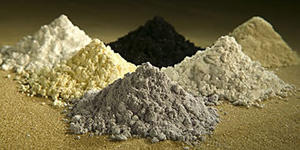Rare Earth elementsRising political, economic tensions over critical minerals
The clean energy economy of the future hinges on many things, chief among them the availability of the scores of rare Earth minerals and other elements used to make everything from photovoltaic panels and cellphone displays to the permanent magnets in cutting edge new wind generators; trouble is, China currently controls about 97 percent of the mining and production of the minerals, and it is using that control to give Chinese companies an advantage and for political pressure on other countries

Rare earths, such as these oxides, are critical to energy products // Source: geology.com
The clean energy economy of the future hinges on many things, chief among them the availability of the scores of rare Earth minerals and other elements used to make everything from photovoltaic panels and cellphone displays to the permanent magnets in cutting edge new wind generators. There is trouble brewing over projected growth in demand for these minerals and the security of their supplies.
A Geological Society of America release reports that last year, for instance, China restricted the export of neodymium, which is used in wind generators. The move was ostensibly to direct the supplies to toward a massive wind generation project within China. The release quotes economics professor Roderick Eggert of the Colorado School of Mines to say that the effect, however, is to create a two-tiered price for neodymium: one inside China and another, higher price, for the rest of the world. The result could be that China not only will control the neodymium supply, but the manufacture of neodymium technology as well.
The geopolitical implications of critical minerals have started bringing together scientists, economists, and policy makers who are trying to find effective policies to deal with the growing problem. In that spirit, yesterday (Monday, 10 October 2011), Eggert and other professors presented their research alongside high-level representatives from the U.S. Congress and Senate, the Office of the President of the United States, the U.S. Geological Survey, in a session at the meeting of the Geological Society of America in Minneapolis.
Among the basics that need to be grasped to understand the current state of affairs is how rare these minerals and elements really are. Some are plentiful, but only found in rare places or are difficult to extract. Indium, for instance, is a byproduct of zinc mining and extraction. It is not economically viable to extract unless zinc is being sought in the same ore, Eggert explained, Others are just plain scarce, like rhenium and tellurium, which only exist in very small amounts in the Earth’s crust.
There are basically two responses to this sort of situation: use less of these minerals or improve the extraction of them from other ores in other parts of the world. The latter would seem to be where most people are heading.
“China’s efforts to restrict exports of mineral commodities garnered the attention of Congress and highlighted the need for the United States to assess the state of the Nation’s mineral policies and examine opportunities to produce rare earths and other strategic and critical minerals domestically,” read the session abstract of Kathleen Benedetto of the Subcommittee on Energy and Mineral Resources, Committee on Natural Resources, U.S. House of Representatives. “Nine bills have been introduced in the House and Senate to address supply disruptions of rare earths and other important mineral commodities.”
Benedetto explained the meaning and status of those bills, and what it will take to get them signed into law.
“Deposits of rare earth elements and other critical minerals occur throughout the Nation,” read the abstract for another prominent session presenter: Marcia McNutt, director of the U.S. Geological Survey. She put the current events in the larger historical perspective of mineral resource management, which has been the USGS’s job for more than 130 years. “The definition of ‘a critical mineral or material’ is extremely time dependent, as advances in materials science yield new products and the adoption of new technologies result in shifts in both supply and demand.”
The President’s Office of Science and Technology Policy has addressed the issue as well. Cyrus Wadia presented a five-point strategy to begin addressing the matter. The first point is to mitigating long term risks associated with the use of critical materials. The second, diversify supplies of raw materials. Third, to promote a domestic supply chain for areas of strategic importance like clean energy. Fourth, inform decision makers; and fifth, prepare the workforce of the next generation.
